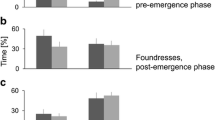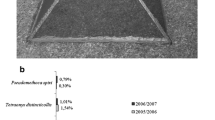Summary
The social parasiteSulcopolistes atrimandibularis invades the nest ofPolistes biglumis bimaculatus after nest initiation, during the pre-emergence colony stage, when only the foundress is present. The colony behaviour of the parasites and the hosts was observed in small glass boxes in the laboratory.
S. atrimandibularis females passively invadePolistes colonies and do not react to the initial attacks by the foundresses. At first, the parasite avoids contact with the host queen when she is on the nest, but after a few hours she becomes more active and dominant. In this way, the parasite subdues the host queen without fighting her. It is possible that the success of this invasion process is due to a strong pheromonal component. Both the timing of usurpation and the non aggressive strategy of nest invasion are thought to be adaptations to the mountain climate where the two species live.
Resume
Le parasite socialSulcopolistes atrimandibularis envahit le nid dePolistes biglumis bimaculatus un certain temps après sa fondation mais avant l'éclosion de la première ouvrière hôte, quand la fondatrice est encore seule. Le comportement des parasites et des hôtes a été observé dans de petites cages en laboratoire. Les femellesS. atrimandibularis envahissent pacifiquement les colonies dePolistes et ne réagissent pas aux attaques initiales de la fondatrice. Le parasite évite les contacts avec la reine hôte quand elle se trouve sur le nid, mais devient plus actif et dominant après quelques heures. De cette façon, le parasite subjugue la reine hôte sans l'attaquer. Il est possible que le succès de cette invasion extrêmement prudente soit dû à une forte composante pheromonale. Tant la période d'usurpation que la stratégie non agressive de l'invasion du nid sont supposés être une adaptation au climat de montagne sous lequel ces espèces vivent.
Similar content being viewed by others
References
Akre R.D., 1982. — Social wasps in:Social Insects. H. Hermann Edit.,4, 1–105.
Alford D.V., 1975. —Bumblebees. Davies-Poynter, publ., London, 356 pp.
Beaumont J. de, Matthey R., 1945. — Observations sur lesPolistes parasites de la Suisse.Bull. Soc. vaudoise Sci. nat., 62, 441–454.
Cervo R., Lorenzi M.C., Turillazzi S. 1988. —Sulcopolistes: Usurpazione e controllo contemporaneo di più colonie diPolistes (Hymenoptera, Vespidae).Atti del XV Congr. Naz. Ital. di Entom., L'Aquila, 1079–1080.
Cervo R., Lorenzi M.c., Turillazzi S., 1990. —Sulcopolistes atrimandibularis, social parasite and predator of an alpinePolistes (Hymenoptera, Vespidae). (submitted).
Demolin G., Martin J.C., 1980. — Biologie deSulcopolistes semenowi (Morawitz) parasite dePolistes nimpha (Christ), Hymenoptera Vespidae.Congrès sur les Sociétés d'Insectes (U.I.E.I.S., Section française) Sénanque, 18–20 septembre 1980.
Distefano L.S., 1969. — Osservazioni suSulcopolistes sulcifer (Zimmermann) parassita sociale diPolistes gallicus (L.) (Hym. Vesp.). Boll. delle sedute dell'Acc.Gioenia Sc. Nat. Serie IV,9, fasc. 10.
Downing H.A., Jeanne R.L., 1983. — Correlation of season and dominance status with activity of exocrine glands inPolistes fuscatus (Hymenoptera: Vespidae).J. Kansas Entomol. Soc., 56, 387–397.
Fisher R.M., 1983a. — Evolution and host specificity: a study of the invasion success of a specialized bumblebee social parasite.Can. J. Zool., 62, 1641–1644.
Fisher R.M., 1983b. — Inability of the social parasitePsithyrus ashtoni to suppress ovarian development in workers ofBombus affinis (Hymenoptera: Apidae).J. Kans. Entomol. Soc., 56, 69–73.
Fisher R.M., 1984. — Recognition of host nest odour by the bumblebee social parasitePsithyrus ashtoni (Hymenoptera: Apidae).N. Y. Entomol. Soc., 91, 503–507.
Frison T.H., 1926. — Contribution to the knowledge of the interrelations of the bumblebees of Illinois with their animate enviroment.Ann. ent. Soc. Am., 19, 203–235.
Gamboa G.J., Dew H.E., 1981. — Intracolonial communication by body oscillation in the paper wasp,Polistes metricus.Insect. Soc., 28, 13–26.
Greene A., Akre R.D., Landolt P.J., 1978. — Behavior of the yellowjacket social parasite,Dolichovespula arctica (Rohwer) (Hymenoptera Vespidae).Melanderia, 29, 1–28.
Jeanne R.L., 1977. — Behavior of the obligate social parasiteVespula arctica (Hymenoptera: Vespidae).J. Kan. Entomol., Soc., 50, 541–557.
Londolt P.J., Akre R.D., 1979. — Occurence and location of exocrine glands' in some social Vespidae.Ann. Entomol. Soc. Am., 72, 141–148.
Lorenzi M.C., Turillazzi S., 1986. — Behavioural and ecological adaptations to the high mountain environment ofPolistes biglumis bimaculatus.Ecol. Entomol., 11, 199–204.
Lorenzi M.C., Cervo R., Turillazzi S., 1990. — Effects of the social parasitism ofSulcopolistes atrimandibularis on the colony cycle and brood production ofPolistes biglumis bimaculatus (Hymenoptera, Vespidae). (submitted).
Michener C.D., 1974. — The social behavior of the bees.The Belknap Press of Harvard University Press, Cambridge, Massachusetts, 404 pp.
Reed H.C., Akre R.D., 1982. — Morphological comparisons between the obligate social parasite,Vespula austriaca (Panzer), and its host,Vespula acadica (Sladen) (Hymenoptera Vespidae).Psyche, 89, 183–195.
Reed H.C., Akre R.D., 1983a. — Colony behavior of the obligate social parasiteVespula austriaca (Panzer) (Hymenoptera, Vespidae).Insectes Soc., 30, 259–273.
Reed H.C., Akre R.D., 1983b. — Usurpation behaviour of the Yellowjacket Social ParasiteVespula austriaca (Panzer) (Hymenoptera: Vespidae).Am. Mid. Nat., 110, 419–432.
Sakagami S.F., Fukushima K., 1957. —Vespa dybowskii André as a facultative temporary social parasite.Insectes Soc., 4, 1–12.
Scheven J., 1958. — Beitrag zur Biologie der Schmarotzefeldenwespen.Insectes Soc. 5, 409–438.
Taylor L.H., 1939. — Observations on social parasitism in the genusVespula Thomson.Ann. Entomol. Soc. Am., 32, 304–315.
Turillazzi S., Cervo R., Cavallari I., 1990. — Invasion of the nest ofPolistes dominulus by the social parasiteSulcopolistes sulcifer (Hymenoptera, Vespidae).Ethology, 84, 47–59.
West Eberhard M.J., 1986. — Dominance relations inPolistes canadensis (L.), a tropical social wasp.Monitore zool. ital. (N.S.)20: 263–281.
Weyrauch W., 1937. — Zur Systematik und Biologie der KuckuckswespenPseudovespa, Pseudovespula andPseudopolistes.Zool. Jahrb. (Syst.) 70, 243–290.
Author information
Authors and Affiliations
Additional information
Study supported by funds of the Ministero della Pubblica Istruzione (60%).
Rights and permissions
About this article
Cite this article
Cervo, R., Lorenzi, M.C. & Turillazzi, S. Nonaggressive usurpation of the nest ofPolistes biglumis bimaculatus by the social parasiteSulcopolistes atrimandibularis (Hymenoptera Vespidae). Ins. Soc 37, 333–347 (1990). https://doi.org/10.1007/BF02225996
Received:
Accepted:
Issue Date:
DOI: https://doi.org/10.1007/BF02225996




